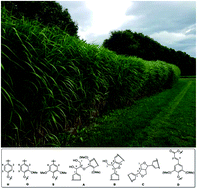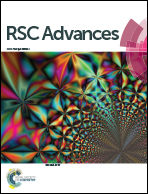Comparing chemical composition and lignin structure of Miscanthus x giganteus and Miscanthus nagara harvested in autumn and spring and separated into stems and leaves†
Abstract
Miscanthus crops possess very attractive properties such as high photosynthesis yield and carbon fixation rate. Because of these properties, it is currently considered for use in second-generation biorefineries. Here we analyze the differences in chemical composition between M. x giganteus, a commonly studied Miscanthus genotype, and M. nagara, which is relatively understudied but has useful properties such as increased frost resistance and higher stem stability. Samples of M. x giganteus (Gig35) and M. nagara (NagG10) have been separated by plant portion (leaves and stems) in order to isolate the corresponding lignins. The organosolv process was used for biomass pulping (80% ethanol solution, 170 °C, 15 bar). Biomass composition and lignin structure analysis were performed using composition analysis, Fourier-transform infrared (FTIR), ultraviolet-visible (UV-Vis) and nuclear magnetic resonance (NMR) spectroscopy, thermogravimetric analysis (TGA), size exclusion chromatography (SEC) and pyrolysis gas-chromatography/mass spectrometry (Py-GC/MS) to determine the 3D structure of the isolated lignins, monolignol ratio and most abundant linkages depending on genotype and harvesting season. SEC data showed significant differences in the molecular weight and polydispersity indices for stem versus leaf-derived lignins. Py-GC/MS and hetero-nuclear single quantum correlation (HSQC) NMR revealed different monolignol compositions for the two genotypes (Gig35, NagG10). The monolignol ratio is slightly influenced by the time of harvest: stem-derived lignins of M. nagara showed increasing H and decreasing G unit content over the studied harvesting period (December–April).



 Please wait while we load your content...
Please wait while we load your content...